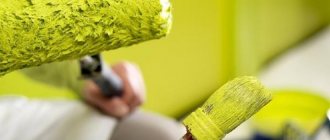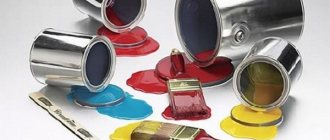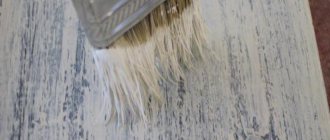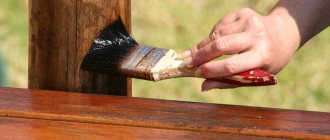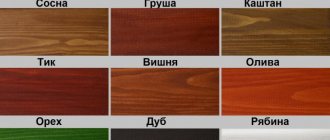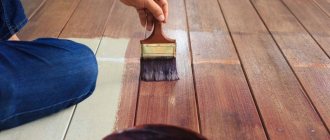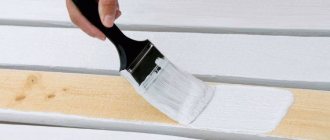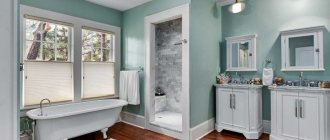During renovation, most people think about the design, color scheme and general interior of the premises. However, when it comes directly to wall decor, the question arises about choosing paint. Construction stores offer a huge selection of coatings: from classic white to decorative ones with mother-of-pearl or marble effects. How not to get lost in the colorful variety and understand which paint is suitable for your purposes, read the article.
Composition of paints
Most paint and varnish materials, which include not only varnishes and paints, but enamels, primers, and putties, are made according to a single component scheme. They must contain:
- film formers
or binders, that is, the material that leads to the formation of a film on the surface; - pigment
, which gives the material its original color; - filler
, which saves pigment and gives the product physical properties, such as strength, shine, application properties; - solvents
and special
additives
- fire-resistant defoamer, fungicidal substances that protect the material from mold and fungi.
The level of the product itself directly depends on how well the components are selected and mixed. The paint of a self-respecting manufacturer contains from 8 to 20 components. It should be noted that good components are quite expensive for manufacturers, so they are forced to keep prices quite high.
Film former value
– bind all components of the paint and adhere it to the substrate.
The main characteristics of paint, its durability and adhesion to the substrate depend, first of all, on the film former or, more simply, on the binder. The binder affects the durability, service life of the coating under different operating conditions, gloss and drying time, as well as painting properties .
To improve the adhesion, elasticity and other properties of polymer materials, special functional groups are introduced into the composition of the polymer film. The latter method is implemented either through copolymerization of the binder, or by introducing additives during the production of the paint itself. Thus, the copolymer
synthetic resin is a polymer whose macromolecules include various monomer units, which makes it possible to control the performance properties of polymers over a wide range.
By choosing the second component wisely, you can, for example, reduce the cost of the dispersion without compromising its consumer properties. This applies primarily to paints based on styrene acrylates, vinyl acrylates and vinyl acetates. The term terpolymer is also used to name a polymer made from three monomers.
According to the chemical nature of the binder, all paints are divided into the following main types: oil, alkyd, epoxy, emulsion, silicate.
Pigments
are fine-grained dyes that are “responsible” for the hiding power and color of the paint. Colored fillers are usually: flock particles, chips, natural and tinted stone chips or quartz sand, water-insoluble pigmented particles with colored dyes. Color pigments are traditionally divided into organic and inorganic.
A filler is a targeted additive. Natural inorganic fillers used for paints and varnishes are obtained by grinding, enrichment, and heat treatment of rocks and minerals. Fillers for paints and varnishes can serve as:
- kaolin (clay);
- microcalcite (ground marble, crystalline calcium carbonate)
- talc (microtalc, technical talc)
- chalk, mica, etc.
Thus, when talc, whose particles have a flat shape, is introduced into the system, the material is not only strengthened, but also its weather resistance increases. Ground mica improves heat resistance and prevents film cracking at high temperatures.
Conventionally, solvents can be divided into solvents
and thinners.
What is the fundamental difference? The solvent dissolves the binder and at the same time reduces the viscosity, that is, it increases the fluidity of the paint. The thinner only reduces the viscosity. The manufacturer is required to indicate the solvent suitable for this type of paint. Based on the type of solvent, paints and varnishes are classified into two classes: water-dispersible and organic-soluble.
To improve the technological and performance characteristics of paints, various additives
. These additives (stabilizers, emulsifiers, antiseptics, fungicidal additives, etc.) are contained in paints in very small quantities, but they can decisively improve certain properties of the coating. In addition, their cost significantly affects the price of the final product.
Some more useful tips
- It is better to add thinner to the paint in the proportion indicated on the packaging (indicated as a percentage). If there is too much paint, the properties of the paint may change - wear resistance and coverage will deteriorate, the degree of gloss will change, and marks from the roller or brush will remain on the surface itself.
- It is better to apply a second coat of paint after the first has completely dried. Drying speed is affected by factors such as humidity, temperature, and air movement.
(Total: 1 , average 5.00 out of 5)
Loading…
Characteristics of paints
Let us list the main indicators of paints and varnishes:
- Covering power.
- Paint consumption.
- Gloss level.
- Resistant to wet abrasion.
- Grind
or maximum grain size. - Weather resistance.
- Light fastness.
- Hydrophobicity.
- Thixotropy
. - Adhesion
. - Environmentally friendly.
Covering power
– this is the ability of paints and varnishes to hide the color of the surface when applied to a substrate. The hiding power is checked by applying paintwork to the surface where black and white areas alternate until the difference in shade between them completely disappears. In accordance with GOST, hiding power is expressed in grams of the amount of dried paint and varnish material required to cover one square meter of substrate. The hiding power of paint depends on many parameters, but primarily on the difference in the refractive index of the binder and pigment, binder and filler, on the particle size of the filler and pigment, as well as on the amount of the latter. The higher the hiding power, the lower the paint consumption.
In accordance with the German standard DIN EN 13300, gradation into covering classes is carried out on the basis of the manufacturer's data on the hiding power of the paint when painting a black and white base (checkerboard). The contrast ratio determines the difference between a painted surface with a black base and a painted surface with a white base.
| Coverage class | Contrast ratio, % |
| Class 1 | ≥ 99,5 |
| Class 2 | ≥ 98 and < 99.5 |
| Class 3 | ≥ 95 and < 98 |
| Class 4 | < 95 |
Paint consumption
shows how much liquid paint is needed to cover one square meter of an ordinary surface. Since the surface can be absorbent or non-absorbent, have a different color, etc., the consumption always fluctuates within certain limits (from and to). Consumption is, of course, related to the hiding power of the paint. The simplest way to calculate paint consumption, with a known hiding power and dry residue, is given below. Covering capacity – 180 g/m2. Dry residue – 60%. Consumption = (Spreading power / Dry residue) * 100%. Consumption = 300 g/m2.
To calculate the consumption for a single-layer coating, it is necessary to divide the resulting figure by two (150 g/m2) and determine the range of fluctuations in consumption depending on the type of surface (+/- 20%). Thus, the consumption for a single-layer coating is 120 – 180 g/m2.
Gloss level.
When light hits the paintwork, part of the light is diffusely scattered, and part is reflected at the same angle; The ratio of the intensity of reflected light to the intensity of all scattered light gives a qualitative characteristic of gloss.
| Designation | Reflectometer readings |
| Glossy | ≥ 60 (measurement angle 60°) |
| Semi-gloss | ≥ 10 (measuring angle 85°) < 60 (measuring angle 60°) |
| Matte | < 10 (measuring angle 85°) |
| Deep Matte | < 5 (measuring angle 85°) |
The “semi-gloss” category also includes “semi-matte” and “silky gloss,” which are less glossy than “semi-gloss.” Such properties of coatings as resistance to washing and abrasion, ease of cleaning, the ability to use detergents, etc. higher for glossy paints.
Resistant to wet abrasion.
The wet abrasion resistance of the coating is tested according to DIN 13300 (German standard) as follows:
– a layer of material 250 microns thick is applied;
– the thickness of the dried layer is measured;
– a special sponge passes in both directions along the surface of the material exactly 200 times;
– the thickness of the remaining layer is measured.
Based on the size of the layer erased with a sponge, materials are divided into coassas.
| Sustainability... | Amount of erased layer |
| Class 1 | < 5 µm |
| Class 2 | ≥ 5 µm and < 20 µm |
| Class 3 | ≥ 20 µm and < 70 µm |
| Class 4 | < 70 µm with 40 sponge strokes |
| Class 5 | ≥ 70 µm with 40 sponge strokes |
Grinding
or maximum grain size - a parameter characterizing the size of pigment particles in paints.
| Designation | Grain size | Material |
| Small | Up to 100 microns | Interior paints |
| Average | Up to 300 µm | Facade paints, smooth plasters |
| Rude | Up to 1500 microns | Fine structural plasters |
| Very rude | More than 1500 microns | Rough structural plasters |
Weather resistance
– a property of a paint coating that determines the resistance of decorative and operational properties to the destructive effects of various climatic factors: rain, sun, wind, high and low temperatures. Paints and varnishes are analyzed for weather resistance using full-scale tests, or during accelerated tests in climate chambers, where one test cycle consists of alternating exposure of the sample to UV radiation, high and low temperatures and various relative humidity, as well as carbon disulfide vapor.
Lightfastness
– the ability of paint to withstand exposure to sunlight and especially ultraviolet radiation (wavelength of ultraviolet radiation 270-400 nm). It is applied mainly to the binder, determining its suitability for external use. In addition to the fading of pigments, which is determined by their color fastness
, destruction of the paint film may occur, which is most often expressed in yellowing and clouding of the paint and varnish. Light resistance can be adjusted by using special UV absorber additives.
Hydrophobicity
– a property of a paint coating that characterizes the tendency of the film not to be wetted by water and polar solvents. Hydrophobicity characterizes only the surface of the coating and can be enhanced by the use of water-repellent additives and waxes. Hydrophobicity correlates with water absorption and weather resistance properties, which is very important for façade paints.
Thixotropy
– the ability of a material to restore its physical properties after external influence. Thixotropic paint does not flow from a vertical surface. When stirring, it becomes quite liquid, the viscosity of the paint decreases sharply, but after stopping stirring, the paint immediately becomes thicker. Thixotropic paint also behaves when sprayed; it passes through the sprayer quite easily, but when it hits the surface, the viscosity increases sharply.
Adhesion
– adhesion of the paint coating to the surface being painted, one of the main characteristics of paint and varnish materials. Adhesion can be mechanical, chemical or electromagnetic in nature and is measured by the pull-off force per unit area. To improve the adhesion of polymer materials to the substrate, special functional groups are introduced into the composition of the polymer film.
Environmental friendliness
– it is harmless to health and the environment. Recently, materials made using environmentally friendly components, the so-called “Green Paints,” have appeared in the line of each manufacturer. They do not emit harmful fumes at all. These paints are recommended for use in rooms where a child or person with allergies will live. In many European countries there are a number of laws and regulations that limit the use of materials made with hazardous substances for interior work. Therefore, most serious manufacturers are gradually eliminating harmful components (even if their effect has not yet been sufficiently studied) from the composition of their products. In any case, holding in your hands interior paint made in Western Europe or the USA, you can safely say that it does not contain mercury, zinc white, lead, cadmium compounds, chlorinated phenols - in short, substances that have an extremely negative effect on well-being and human health. Most manufacturers, when producing an environmentally friendly paint series, assign it a special designation that helps the consumer understand that this is an environmentally friendly product.
Special dyes
To paint facades and perform decorative work, special enamels are used to obtain a relief surface. There are paints with a narrow purpose (for example, for obtaining seal impressions or for printing designs on clothing or paper). When selecting special dyes, you should take into account the specifics of the work being performed.
Structural
Structural enamels contain thickeners and insoluble powders that allow the formation of a rough coating (for example, imitating the structure of wood or ripples on the surface of water). After polymerization, the surface is coated with latex and acrylic-based dyes that provide the required color range.
It is possible to add pigment to the structural material before application, which simplifies the painting technology and reduces the cost of painting or finishing work.
Decorative
Decorative paints are designed to imitate a special coating (for example, leather, old wood or natural stone). The pigments introduced into the composition can have a pearlescent or metallic effect or shimmer in several shades. They are distinguished by their high price and demanding qualifications of the painter; enamels are used indoors. When applied to the external parts of houses, they quickly lose their original appearance (the disadvantage is partially compensated by a layer of glossy synthetic varnish that can withstand climatic influences).
Decorative paints are designed to create imitation surfaces.
Stamp
The materials contain pigments, glycerin and a solvent (water, alcohols or solvent). They are used for applying stamps to paper; they penetrate well into surface layers, thereby complicating the etching procedure. Stamp inks are applied to special foam pads, which are installed in the stamp tray. The materials do not contain aggressive components that destroy cliches.
For facade
Facade paints and varnishes protect walls from mechanical damage and precipitation, and give the building an original design. Enamels can be based on silicate, rubber, emulsion or acrylic base. The coating should not be destroyed under the influence of ultraviolet radiation and has a maximum service life (from 7 to 20 years).
Lime façade materials, used for budgetary or temporary repairs, stand apart.
Aerosol
For accelerated application, water-based or synthetic-based enamels are used, packaged in aerosol cans with a capacity of up to 1 liter. Before use, shake the tank vigorously for 2-3 minutes, and then spray the material onto the surface at a distance of 200-300 mm. To obtain an even coating, it is recommended to apply 2-3 layers; for additional protection, use glossy or matte varnish.
Aerosol paint is indispensable when painting small parts and hard-to-reach surfaces.
Types of paints.
According to the chemical nature of the binder, all paints are divided into several types. Let's consider some of them, namely: alkyd, water-dispersed, silicate.
Alkyd paints.
Their binding element is alkyd resin. The concept Alkyd was introduced in 1927 and comes from a contraction of two words: al kohol und ac id . (alcohol and acid). Alkyd resin is obtained by cooking vegetable oils (linseed, tallow, soybean, etc.) together with acids. The elasticity of the coating directly depends on the fat content of the alkyd resin. Special additives - driers - regulate the drying rate of alkyd resins. Alkyd paints are diluted with drying oil, turpentine, and white spirit (purified kerosene).
The positive properties of alkyd paints are:
- self-curing at room temperature in the form of one-component systems;
- very wide range of compatibility and solubility;
- the ability to almost unlimitedly change properties by choosing the appropriate starting materials and synthesis conditions;
- good wetting of pigments;
- good spreading ability, leading to high-quality distribution of coatings over the surface;
- relatively low cost.
Alkyd paints are used to protect surfaces from corrosion both inside and outside the building. They are well suited for coating wood or metal and can be used both indoors and outdoors. Alkyd paints are suitable for painting doors, window frames, furniture, and radiators. They are often used to paint walls and ceilings in kitchens and bathrooms. Alkyd paints are exclusively suitable for painting some surfaces, including radiators. They form a coating that is denser and more durable than water-dispersed compositions.
These paints are non-toxic, light and water resistant, and have a much shorter drying time than oil paints.
The disadvantages of alkyd paints are:
- fire hazard;
- unsatisfactory chemical resistance (especially to alkalis);
- increased brittleness and yellowing over time (even in the absence of light);
- relatively rapid loss of gloss (with chalking);
- relatively slow drying (especially with a high content of fatty acid residues).
In terms of environmental friendliness, they are inferior to water-dispersion paints. The specific smell of paint persists even after drying. In some cases, impermeability to water vapor is also a disadvantage.
Alkyd paints have high weather resistance. As a rule, the enamel film is resistant to temperature changes from minus 50ºС to plus 60ºС. Paints can be glossy, matte, semi-matte. For example, for exterior work, preference should be given to glossy alkyd paints, since the service life of glossy alkyd paint is 20% higher than that of other alkyd paints. Alkyd paint has sufficient abrasion resistance. Thanks to these properties, alkyd paint is suitable for painting not only walls and ceilings, but also floors.
Water-dispersion paints.
Water-dispersion paint (the old name is water-emulsion paint) is an aqueous composition in which aqueous dispersions are used as a binder:
- vinyl acetate (PVA);
- acrylic;
- butadiene-styrene (latex);
- siloxane and silicone;
- polyurethane copolymers.
A dispersion is a suspension of solid particles in liquids. Water-dispersion paints are diluted with water (do not dissolve). Their binder base and coloring particles are distributed in an aqueous environment, forming a stable dispersion. During the process of water evaporation, they come closer and when contact occurs, they stick to each other, forming a film. Once the paint dries, it cannot be washed off with water. But it’s easy to wash off your hands and tools (until it dries). Water-based paints are among the most economical and easy to apply products. They are easily applied to the surface, including wet ones, by spraying, pouring, as well as by roller, brush and dry at normal temperatures, forming matte, porous, vapor- and air-permeable films. The paints have good hiding power. In interiors, they are used mainly for painting walls and ceilings.
Water-dispersed compositions practically do not contain organic solvents, so they are odorless and environmentally friendly.
As a rule, water-dispersed materials lose their properties when frozen, so in cold weather they should be stored in heated rooms.
PVA based paints.
Dispersions based on vinyl acetate homopolymer are no longer used in coatings due to the relatively high fragility of films and low resistance to hydrolysis. Copolymers with vinyl esters of higher carboxylic acids, acrylates or ethylene produce films with excellent elasticity, weather resistance and water resistance and are widely used in water-based paints and plasters based on synthetic resins.
Dispersions of vinyl acetate copolymers with ethylene have the ability to form films even at low temperatures, and films based on them are lightfast and also relatively resistant to alkaline hydrolysis. Copolymers of this composition resemble rubber in properties.
Vinyl acetate copolymer with ethylene is a lightweight and elastic material with good shock-absorbing properties, superior to polyethylene in transparency and elasticity at low temperatures, and has increased adhesion to various materials. Ethylene-vinyl acetate copolymers are unique products that, as the content of acetate moieties increases, exhibit the full range of properties characteristic of the transition from polyethylene to polyvinyl acetate.
Acrylic paints.
Water-borne acrylic-based paints are the most popular; these paints have a wider range of uses; they can be used to paint not only ceilings, but also walls. They are not afraid of wet cleaning, have good resistance to abrasion, so they can be painted in damp rooms. Another advantage of acrylic paints is the large selection of colors for tinting, from light to dark. Acrylic paints retain color well and withstand intense UV radiation. In addition, they are easy to use and dry quickly. To obtain a high-quality finish, it is enough to apply two layers to the surface. In this case, the coating is not only “breathable” (which allows these paints to be successfully used on mineral surfaces), but also quite elastic. In addition, it has excellent adhesion to the surface being painted and has increased resistance to washing and wet abrasion. Only acrylics make it possible to produce paints with high elasticity, water-repellent properties and, at the same time, high vapor permeability. Suitable for alkaline bases.
Latex paints.
The main advantage of latex paints over other water-based paints is: increased resistance to wet abrasion, the ability to obtain silky matte surfaces, and the ability to cover the base with a thin layer.
All this makes it possible to paint walls using wallpaper and textured plaster, preserving their texture.
Latex paints differ in the degree of gloss of the finished surface. At the same time, paint with a higher degree of gloss is more resistant to wet cleaning. But glossy paint has a disadvantage: it reveals all the unevenness of the wall, so if you decide to use such paint, you need to take care of good preparation of the wall.
Siloxane and silicone paints
– the most modern facade paints, combining almost all the best properties of acrylic and silicate paints. The binder in them is emulsified organosilicon resins.
| CH3 CH3 –Si–O–Si–O-… CH3 CH3 |
An organosilicon chain consisting of alternating silicon and oxygen atoms is called siloxane. Molecules containing several chains of siloxane linked together are called polysiloxane or silicone.
The differences between silicone and siloxane materials are as follows:
- Siloxane materials contain acrylic resins with the addition of a small amount (in most cases about 1%) of siloxane filler. Siloxane serves primarily only to repel water and increase vapor and gas permeability. As the layer of material dries, siloxane molecules float to the surface and form a water-repellent layer.
- Silicone paints, on the other hand, contain an emulsion of silicone resin i.e. real silicone adhesive (usually 2% - 5%). When dried, the silicone emulsion is distributed throughout the entire volume of the film, providing unique properties to the entire volume of the material, and not just its surface. Silicone emulsion is not destroyed by ultraviolet radiation and is not susceptible to atmospheric influences.
Silicone paints have vapor permeability comparable to silicate paints, combined with a high degree of hydrophobicity. Unlike silicate paints, they form a non-water-wetted surface on which rainwater remains in drops without wetting the base. The film formed by silicone paints has the highest elasticity and does not cause surface stress on the substrate, and therefore does not form microcracks.
After the paint dries, the surface looks like natural material. The film structure has the ability to self-clean. Silicone coatings have good adhesion, allow carbon dioxide to pass through well and repel water, provide protection from UV radiation, and are highly elastic and therefore durable. They can be applied to almost all substrates available in construction practice. Unlike acrylic polymers, silicone resins are not thermoplastic, meaning they do not soften when temperature increases, and are electrically neutral. Combined with high water-repellent properties, this means that the surface painted with silicone paints is practically not contaminated. Silicone paints are suitable for almost all types of mineral surfaces. They are also highly compatible with both mineral and acrylic or latex paints. It is believed that even old silicate and lime coatings can be repainted with silicone paints. The most important difference between siloxane paints and acrylic paints is their resistance to alkalis.
Silicone coatings, like silicate ones, do not support the development of microorganisms. Therefore, they do not require the use of special fungicidal and algaecidal additives, which are necessary in acrylic paints.
Working with siloxane and silicone paints requires virtually no precautions - unlike silicate paints, they are not aggressive.
Their only drawback is their high cost.
Polyurethane paints.
Polyurethane paints and varnishes come in one- and two-component types.
Two-component paints are cured by a chemical reaction. One-component paints are cured by atmospheric moisture and are conventional paints modified with polyurethane.
One-component polyurethane paints are not a competitor to two-component ones, however, they also have remarkable properties:
- they have exceptionally good adhesion;
- dry quickly;
- form a coating on the surface that is both hard and elastic at the same time;
- have an increased level of wear resistance and are able to withstand mechanical loads, including shock;
- they successfully withstand pressure, water, elevated temperatures, are light-resistant and frost-resistant;
- insensitive to chemical influences, including frequent use of detergents or oils;
- provide corrosion protection to metal surfaces.
In addition, such paints and varnishes do not have a toxic odor. These are the best and most durable paints. The thermal properties of polyurethane coating have opened a wide path for it to be used in the production of furniture and laminated parquet.
Silicate and dispersion-silicate paints.
Silicate paints can basically be divided into two groups:
- Two-component silicate paints
(2K, also called pure silicate paints), consisting of liquid potassium glass, pigments and fillers. They do not contain organic components. - Dispersion silicate paints
based on liquid potassium glass, pigments, fillers, synthetic dispersion and, if necessary, a water repellent. The total proportion of organic matter should not exceed 5%.
Two-component silicate paints
have been used to coat mineral substrates for over 120 years. There is liquid potassium glass and liquid soda glass. For the production of paints, predominantly liquid potassium glass is used, since soda glass does not have the same strength characteristics and resistance to atmospheric conditions as liquid potassium glass. In addition to liquid potassium glass as a binder, the paint contains alkali-resistant mineral pigments and fillers. The result is open-pore coatings that are highly permeable to water, water vapor and carbon dioxide. Silicate paint hardens due to silicification. During this process, a water-insoluble, acid-resistant glassy binder is formed from water-soluble potassium glass, also called a fixative.
Dispersion silicate paints.
Dispersion silicate paints have been produced for over 35 years. Compared to pure silicate paints, they are primarily easier to use and have a greater number of application options. They ensure diffusion of water vapor and additionally contain water-repellent additives. Therefore, they demonstrate very good physical and structural properties and optimally protect the painted surface from moisture damaging the walls of the building. Good resistance is based on the so-called double silicification, in which liquid potassium glass reacts both with special fillers and with the mineral surface being painted.
The disadvantages of silicate paints include the impossibility of using them on surfaces previously painted with synthetic organic-based paints.
Peculiarities
Paints are special solutions that have a uniform consistency. Conventionally, these products can be divided into two groups: facade solutions and mixtures for interior work. There are also universal formulations that are suitable for any operating conditions.
Paints for interior use are radically different from each other. They have various properties:
- Resistance to moisture. After drying, a durable film is formed on the surface that does not allow water to pass through. This type of paint is suitable for use in the bathroom or kitchen.
- Strength. This parameter is important for apartments with a large number of residents. The material must resist abrasion well and retain its original properties throughout the entire period of operation. But not all interior paints have such properties. This is important to consider when choosing products.
- Environmental friendliness . This factor is present to one degree or another for each type of solution. Materials for indoor use after drying do not emit any harmful substances into the air, thus not affecting human health.
This type of solution is unique and practical. A variety of shades allows you to choose paint for almost any room. The market offers modifications for both domestic conditions and industrial facilities, where there are special requirements for resistance and durability.
Summarizing
Regardless of the type of paint, a number of preparatory work is required before application. Remove old paint, level and clean the surface. Use a primer for better paint adhesion.
When purchasing paint, carefully study its characteristics - now you know what things you should pay attention to when choosing paint for a particular room. Applying high-quality paint is quite simple - it goes on smoother and dries quickly. If done correctly, the paint will last for many years, and its color will remain as rich as the day it was applied.
Color palette
The palette of most manufacturers is quite diverse, which makes it easy to choose not only the desired color, but also its shade.
In addition to colored ones, the construction market offers paint options available only in white. In addition to these types, liquid dyes are produced, adding which in a certain proportion, you can obtain the necessary colors and shades. So, by adding colored black pigment in various proportions to the main white paint, you can get many shades: from light gray and gray to dark and black. Sometimes this role is played by pigments, and among them there are toxic ones: red lead – orange, lead + zinc – yellow, chromium oxide + manganese – green.
When choosing paint and varnish products in a store, it is important to initially imagine the desired effect, the future room and how the new paint will look in the interior.
Transparent paints are used for protection. They can be shiny or matte, and can shade or emphasize the noble structure of the base.
Different textures for different tasks
In addition to composition, paints are also divided by texture. There are three common options:
- matte paints - the paint does not shine, well suited for a calm design. It is considered a universal option and does not fade over many years;
- Gloss paints are bright paints that have a noticeable shine. It is important to apply to a perfectly smooth base, as any roughness will be noticeable;
- pearlescent paints are paints that seem to shimmer on the surface.
It is worth choosing the texture wisely, as it affects the design no less than the color of the paint.
Classification of paints depending on the purpose and chemical nature of the film-forming substance
By visiting the store, you can find different types of paints. They are classified depending on the purpose and chemical composition of the film-forming substance. Paint and varnish materials can be divided into five groups. The first group contains compounds denoted by the following words:
- dye;
- enamel;
- varnish;
- emulsion paint.
For those paints that consist of only one pigment, when denoting the first group, the name of the pigment is used instead of the word “paint” (for example, red lead). If we turn to the second group, we can note that it talks about the chemical composition and determines the type of film-forming substance. The group is designated by two letters. If you see the designation MA, then this means that this is oil paint. The abbreviation GF indicates glypthal enamels.
The third group of characters is indicated by the number that comes after the hyphen. It indicates the purpose of the composition. If you need paint for exterior use, then you should choose one with a 1 after the hyphen. Two indicates interior paint. To paint the bottom of boats, paint with a four after the hyphen is used. All subsequent numbers indicate a serial number, with the only exception being oil paint.
Why do you need to paint the walls in your apartment?
In modern renovations, new generation interior paints are used. Now covering walls and ceilings with paints is long-lasting and reliable protection. In order for the dye to adhere reliably and the coating to last for many years, it is important to choose the right composition, taking into account the structural features of the material being painted.
As a decorative covering for walls, it can be of various types in terms of color, texture, and degree of gloss.
Paints will help revive the interior and complement it with bright accents, creating a unique charm and emphasizing the individuality of the style.

